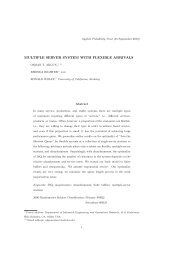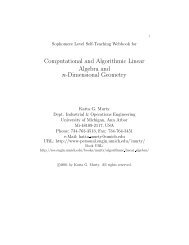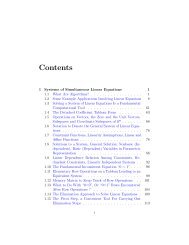Chapter 1 LINEAR COMPLEMENTARITY PROBLEM, ITS ...
Chapter 1 LINEAR COMPLEMENTARITY PROBLEM, ITS ...
Chapter 1 LINEAR COMPLEMENTARITY PROBLEM, ITS ...
You also want an ePaper? Increase the reach of your titles
YUMPU automatically turns print PDFs into web optimized ePapers that Google loves.
28 <strong>Chapter</strong> 1. Linear Complementarity Problem, Its Geometry, and Applications<br />
All variables u1u2u3v1 1 2 3y1 > = 0<br />
and u1 1 = u2 2 = u3 3 = v1y1 =0:<br />
Let (~u1 ~u2 ~u3 ~v1 ~ 1 ~ 2 ~ 3 ~y1) be a solution to this LCP. Let ~ 4 =1; ~ 1 ; ~ 2 ; ~ 3.<br />
Then ~x =( ~ 1 +4 ~ 2 +5 ~ 3 +5 ~ 4 3 ~ 1 +2 ~ 3 +4 ~ 4) is the point in K that is closest to<br />
P0.<br />
1.3.4 Convex Quadratic Programs and LCPs<br />
Associated with PSD Matrices<br />
Consider the LCP (q M), which is (1.6) { (1.8), in which the matrix M is PSD.<br />
Consider also the quadratic program<br />
Minimize z T (Mz + q)<br />
Subject to Mz + q > = 0<br />
z > = 0 :<br />
This is a convex quadratic programming problem since M is PSD. If the optimum<br />
objectivevalue in this quadratic program is > 0, clearly the LCP (q M) has no solution.<br />
If the optimum objective value in this quadratic program is zero, and z is any optimum<br />
solution for it, then (w = Mz + q z) is a solution of the LCP. Conversely if (~w ~z) is<br />
any solution of the LCP (q M), the optimum objective value in the above quadratic<br />
program must be zero, and ~z is an optimum solution for it. Thus every LCP associated<br />
with a PSD matrix can be posed as a convex quadratic program.<br />
Now, consider a convex quadratic program in which Q(x) =cx+ 1<br />
2 xT Dx (where D<br />
is a symmetric PSD matrix) has to be minimized subject to linear constraints. Replace<br />
each equality constraint by a pair of opposing inequality constraints (for example,<br />
Ax = b is replaced by Ax < = b and Ax > = b). Now the problem is one of minimizing<br />
Q(x) subject to a system of linear inequality constraints. This can be transformed into<br />
an LCP as discussed in Section 1.3.3. The matrix M in the corresponding LCP will<br />
be PSD by Result 1.10, since D is PSD. Thus every convex quadratic programming<br />
problem can be posed as an LCP associated with a PSD matrix.










